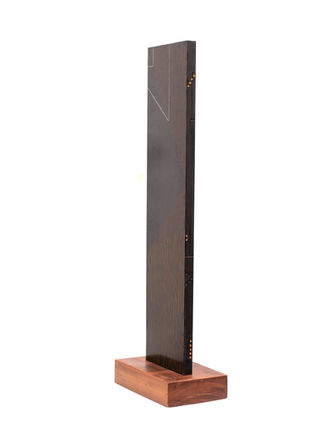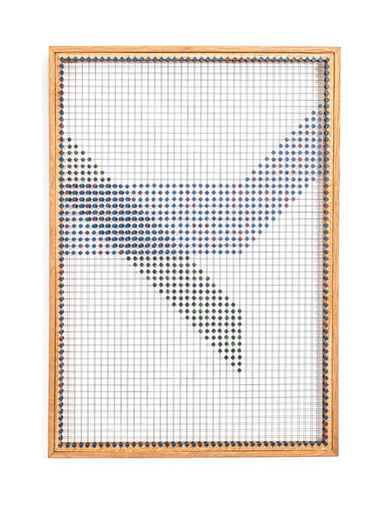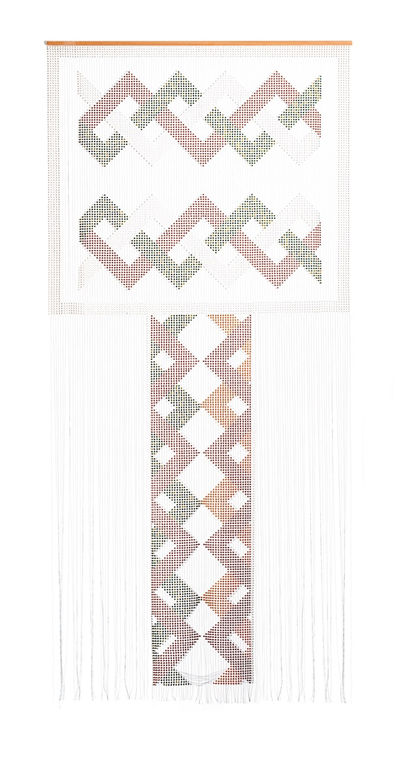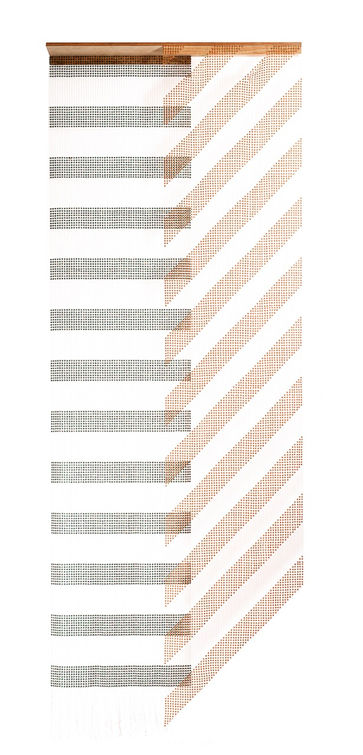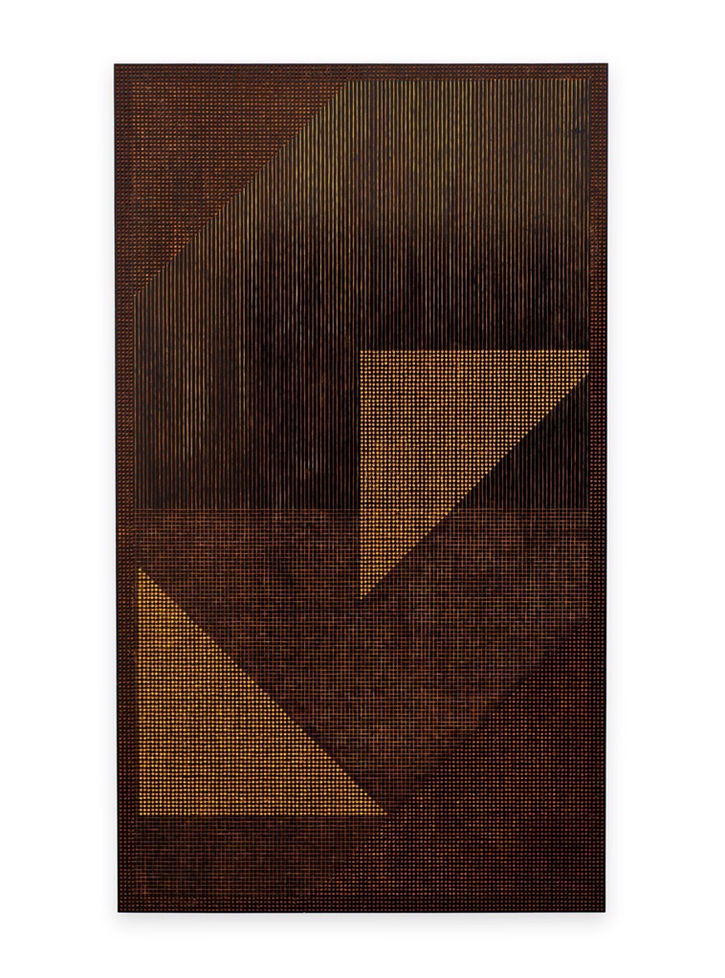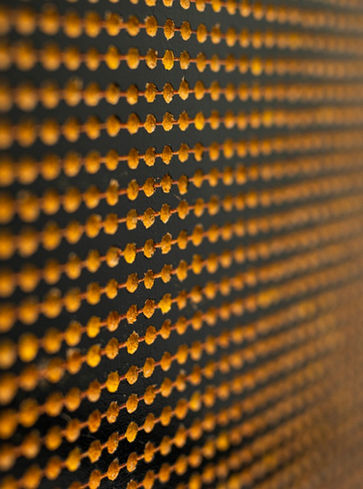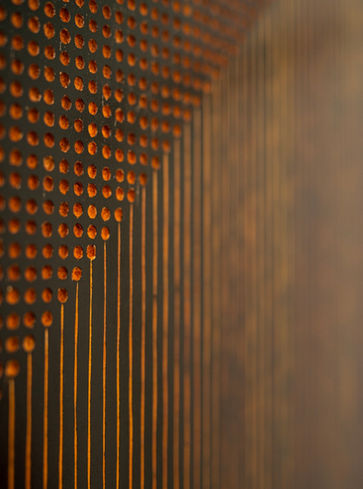


b. 1992 Kimberley, South Africa
Lives and works in Cape Town, South Africa
From her earliest works to the present, Bonolo Kavula’s art has existed between the intersections of painting, printmaking, drawing and installation, pushing the limitations of each. Using the simple unit of the circle and line, Kavula has created a unique visual language that engages with geometric shapes and forms to reimagine the language of 1960s post-minimalism and serial art. While formalist in nature, Kavula incorporates traditional shweshwe cloth into her practice, evoking cultural, ancestral, archival and historical connotations specific to her work. The process is that of excessive repetition, each dot with its own landscape of minutiae, telling of the meditative action of labour, and of the creation of new meaning through deconstruction and transformation.
Kavula obtained a BA(FA) from the Michaelis School of Fine Art at the University of Cape Town in 2014, majoring in Printmaking. Kavula received the 2014 Katrine Harries Print Cabinet Award at the University of Cape Town and she was a founding member of the Cape Town based artist collective, iQhiya. In 2022, Kavula presented her first solo museum exhibition titled Lewatle at the Norval Foundation, in Cape Town, South Africa, as well as a solo exhibition, Soft Landing, at SMAC Gallery in Cape Town, South Africa. In 2021, she presented a solo booth at Art Basel Miami Beach, titled a re kopane ko thabeng, as well as her first solo exhibition, sewedi sewedi, at SMAC Gallery in Cape Town. Her works are included in the Pérez Art Museum Miami (PAMM) Collection in Miami, USA, and the Iziko South African National Gallery Collection in Cape Town, South Africa. This year, Kavula is set to commence an artist-in-residence programme at Fondation CAB, in Brussels, Belgium.

LEBALA
Go gata lebala:
Grounding Bonolo Kavula’s abstractions in ancestral memory
Text by Amogelang Maledu
With spellbinding intricacy, threading, and geometric patterning on carved wood, Bonolo Kavula’s latest body of work continues her multidimensional printmaking practice. The work is titled with a Sesotho-Setswana word – Lebala – which loosely translates to ‘an open field’ or ‘yard’. Herein Kavula invites us into her intimated abstractions of working with the expanse – the expanse of the open field – of ancestral memory within literal familial threads of the historically laden shweshwe fabric.
The word ‘lebala’ is textured with socio-cultural symbolic meaning, it is rooted with metaphorical resonances of grounding oneself through the act of returning home to connect with one’s family and ancestors. During the production of this body of work this is exactly what Kavula did: she went to her late grandparents’ home in Kimberley, in the Northern Cape province of South Africa. She went home – go gata lebala – spending time inhabiting the land.
I have concluded that my artwork is ancestral work.
A calling if you will.
The artwork does not happen in isolation in studio but it follows me home –
this work has forced me to mature spiritually and in so doing
it translates in the work. My artwork is a reflection of my spiritual growth.
Beyond the transcendental significance of Kavula’s vocation, the artist’s career trajectory has also come with the illustrious success of being the inaugural winner of the 2022 Norval Foundation Sovereign African Art Prize (NSAAP).
Even though Kavula has a multifaceted artistic practice straddling various mediums, it was her winning work Tswelopele (2021) for the NSAAP that crystalized her exploratory printmaking process preoccupied with abstraction, geometry, textile, design and more recently, wood. After graduating in printmaking in her Fine Arts degree at the Michaelis School of Fine Art, Kavula has experimented with both the medium’s process-based production and its malleability.
Despite the European colonial history of the imported shweshwe fabric that Kavula makes use of, its material culture still has a socio-cultural currency and index to southern African ‘traditional’ garb. For Kavula, the fabric is also imbued in ancestral familial histories as a material heirloom after receiving her late mother’s red shweshwe dress as a gift from her great grandmother. Thus, her application of how she engages with the geometry of the shweshwe fabric creates a polyphonic visual register of ancestral memory, emblematic in her visual zeitgeist. The process of Kavula’s hanging textile print artworks involves a methodic repetition of punching shweshwe fabric into tiny discs that she glues into patterned geometries on a threaded grid where she forms organic shapes that sometimes intersect. This painstaking meditative process creates optical abstractions, deconstructed and reconstructed into new forms of shweshwe: innovatively interweaving printmaking with textile and sculpture.
Through her dedication to exploring various printmaking techniques, Kavula’s latest body of work expands into patterned wood carvings that function as a hybrid of sculptural paintings/drawings. Much like Kavula’s shweshwe textile print works, the hybrid wood carvings reveal the fluidity of her printmaking process beyond the canonical ink on paper. The woodwork is the artwork and not merely part of a process of printmaking. Kavula’s pictorial idiom of deconstructing and reconstituting materiality into new forms of patterned shapes and geometries illustrates a dedication to the expanse of printmaking’s possibilities. The eponymously titled artwork Lebala is the blueprint of this expansive processes with visual symmetrical patterns that intertwine and conceptually hybridized ideas. Lebala’s punched circular disks in colours yellow, blue and green form a pristine interlocking zigzag patterned frame that Kavula says represents the meeting points of her past-present-future self. The artwork is the first experiment the artist worked on where she was interested in a kind of interplay between shweshwe fabric’s materiality and how it could somehow be applied in other expansive printmaking mediums such as carved wood.
Kavula’s latest body of work continues her bio-poetic artistic practice of forging connections with not only the literal social fabrics of her ancestors, but also through fabricating, threading, and playing with form and materiality. She attunes us to the multiplicities of her abstract expansive printmaking practice that emphasizes material thinking as not just method and creative process – but also – as sociohistorical familial memories and ancestral constellations.



Lebala
(Setswana for 'wide open spaces')
Lebala is the foundation for this body of work. Engaging with geometric forms and negative space, the work attempts to introduce depth into the two-dimensional plains of pattern. Using blue, green and ochre, colours referencing the Kavula’s ancestral homelands, the intertwining pattern represents a meeting of past, present and future self. An associated meaning for lebala, is ‘to forget’. For Kavula this speaks to the her recent spiritual journey to reconnect with her ancestors. By returning to the home where her maternal grandparents lived, Kavula engaged in the practice of "go gata lebala" (stepping on to home ground) - returning home and literally walking the ground your ancestors once inhabited. Spiritually, this act of stepping on the ground of the people who came before you, allows one reawaken your connection to the ancestors and to ask for strength, blessings and support.




Mothusi
(Someone who helps)
This totem is dedicated to my late uncle, Tuelo Sewedi. When I want home go gata lebala I also visited his gravesite. When a family member passes on in my culture we have a moment the day after the funeral where we choose an item of clothing that we can keep that belonged to our loved one. The clothing is for keepsake or one can wear it whenever you want. I chose my uncles brown formal shirt the same way my great-grandmother kept my mother’s dress. I took my uncles shirt with me back to varsity in 2012 and I would make my art and wear it. I wore the very same brown shirt when I was making the ink woodcuts and printing them. I would like to believe that he is with me when I make my art as he was diligent and very hardworking. He did the cooking and cleaning at my grandfather’s house. I get a sense of confidence whenever I wear his shirt more especially as I print because it requires focus.



Tshepa
(trust the process)
One must always take risks when making artwork even if it is at the expense of your time and energy. A new lesson and technique was learnt while making this work - to depend even more strongly on the meeting of the threads and shweshwe discs. The threads holds well and I begin ti trust that more and more as I make my work.

nonyane
(bird)
It plays with the idea that when you see a feather, a message from an angel or spiritual being is being sent you. The artwork also being suspended in the air with the borders of white canvas around it gives it a lightness and quite literally a feeling of wanting to be lifted in the air or even just lifted in spirit and aura.



Re kopane
(We have meet)
This artworks is a literal indication again of meeting. But not close enough - there is a thin layer between ourselves and the spiritual world but it is there and we intersect with our ancestors. We meet, have meet and we continue meeting.
Basireletsi
(Our protectors)
This artwork’s strong and heavy presence represents that of my ancestors in my life. I learnt through my great aunt, Mma Moeng, that her great grandfather was a healer. She shared his surname with me. She said he helped people by going into the fields and using natural herbs. She said he went into the fields. “He just helped people, he was like a herbal doctor” And so Open Field also begins to include my personal history which I am learning.









